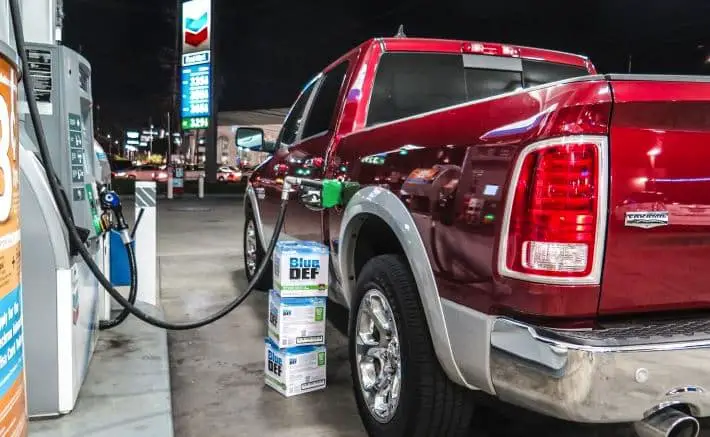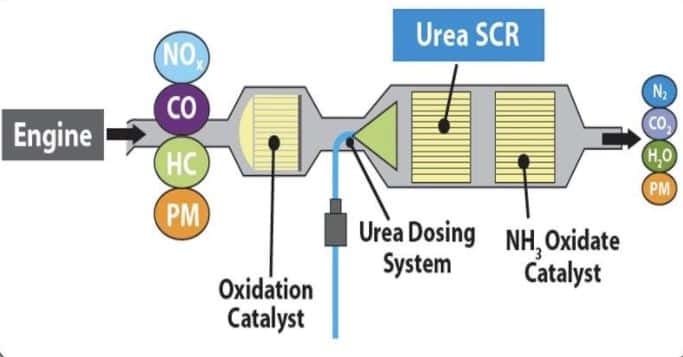
Table of Contents

DEF frequently asked questions and answers
In this article, we’re going to enlighten you more by answering the top questions on DEF.
FAQ about DEF
Here are the questions we cover in this ultimate guide to DEF:
What is DEF?
Diesel Exhaust Fluid known to many as DEF is an aqueous solution of 67.5% water and 32.5% pure urea that is used to chemically reduce nitrogen oxide concentration in diesel exhaust emissions from heavy machinery and trucks.

Best DEF Fluid
It is also important to note that:
- DEF is not an explosive or inflammable substance.
- DEF should not be used as fuel or fuel additive.
- DEF is not poisonous, toxic, or harmful to man or animal.
How do I use DEF?
DEF is a solution that detoxifies the exhaust emission from massive diesel engines by reducing nitrogen oxide contents in these emissions.
Just like the diesel fuel, the DEF has its own storage compartments in machines/ trucks with the selective catalytic reduction system.
DEF tanks are smaller in size and usually designed to have blue caps for easy identification.
What year did diesel exhaust fluid start?
The use of DEF became incorporated in diesel equipment/trucks in 2010 when most diesel engine manufacturers adopted the selective catalytic reduction systems to meet environmental safety laws by the local and federal governments.
How much DEF can I expect my equipment to use?
DEF consumption varies with different engine types, although certain factors like temperature and humidity can also contribute to an increased or decreased consumption.
Ideally, DEF consumption should be approximately 2% to diesel consumption. Recent observations have shown that not all machines maintain these consumption rates as a result of different vehicle operation, loading rate, duty cycle, and many others.
It is essential you take a close study of your machine and observe its DEF consumption rate to know what amount of DEF it consumes.
Is DEF hazardous, toxic, or inflammable?
No. DEF is a non-hazardous, non-toxic and non-inflammable solution. Nevertheless, it is imperative that this solution is handled carefully to avoid spill, eye contact, and accidental ingestion.
What if DEF comes in contact with skin or eyes?
In the event of an accidental splash into the eye or on the skin, the victim is required to thoroughly rinse the eye or skin spot with water and seek medical help from a physician should in case you notice eye reddening or skin irritation.
What is the freezing point of DEF?
DEF will freeze at a temperature of 12 degrees Fahrenheit (-11 deg Celcius), at this temperature both the urea and water will freeze at the same rate. However, the freezing does not alter the DEF concentration or causes any form of degradation on the product.
How much DEF will I need?
The amount of DEF used is dependent on some core factors which include:
- Size of truck/machine and manufacturer.
- The engine type and transmission configuration.
- The workload on the machine or the distance traveled by truck.
Hence it is important to note that class eight vehicles (i.e., tractor-trailers) consume between 3 to 8 gallons of DEF for every 100 gallons of diesel fuel. While non-mobile machinery consumes 8 to 10 gallons of DEF for every 100 gallons of fuel.
How often do I refill DEF?
DEF is usually refilled after every diesel refill. Smaller vehicles and light-duty trucks can be refilled during an oil change, while heavy trucks/equipment do require a regular refill.
What happens when you run out of DEF?
It’s an ordeal to run out of DEF. Running out of DEF comes with reduced engine power, continuous red alarm, and limits your vehicle speed to 5 miles per hour until a refill is done.
How to tell if DEF is bad, old, or contaminated?
It’s simple and easy to tell if a DEF is bad, old, or contaminated from just a glance. The solution appears clear naturally, so if the DEF looks milky or colored, there is a high probability that it is bad, old or contaminated.
If you must get rid of bad DEF, it’s crucial you do it correctly. Never spill bad DEF down a drain or drop off in a waste bin.
It’s important you contact your local government, municipal, and environmental agency for a proper guide on how to dispose the solution.
How do I store DEF?
DEF is mildly corrosive in nature and should be stored in containers made from high-density polyethylene (HDPE) plastic or stainless steel. It should be well packed in bulk tanks and kept indoors in a controlled temperature environment.
DEF degrades over time as a result of its storage temperature and exposure to sunlight. If stored between 10 to 90 degrees Celsius, its shelf life will be approximately 12 months, but if the temperature does not exceed 75 degrees Celsius for a long period of time, the solution can last for as long as 24 months.
Where can I get DEF?
DEF is sold and abundantly available in several retail stores and gas stations. However, we recommend that you purchase from a credible and trusted dealer, that’s the only way you’ll be sure to buy high quality and suitable DEF for your vehicle/machine.
Nevertheless, ensure before using any DEF irrespective of the producer or seller that the solution meets the American Petroleum Institute standard.
How Much Does DEF Cost?
DEF sells for almost the same price as the traditional diesel fuel price per gallon; but it’s important to bear in mind, that its consumption rate is far less compared to the fuel.
Is diesel exhaust fluid (DEF) harmful to humans?
DEF is non-toxic to humans and is not a hazardous substance. There have been issues brought up by various manufacturers questioning the legitimacy of these opinions.
Old and degraded diesel exhaust fluid will emit harmful ammonia gases if not disposed of properly.
Agricultural DEF, where purity is not as regulated as automotive DEF, may lead to skin irritations. Allergic medical alerts may sound when any person inhales the fluid.
There may be superficial inflammations to the nose and throat.
Any additional symptoms and a doctor should be alerted at once. If DEF is spilled on the skin, wash off at once with an inert cloth and water.
What Color is Diesel Exhaust Fluid?
DEF is a clear colorless liquid. Shelf life for diesel exhaust fluid is two years after which the urea may cloud the solution.
Who Invented Diesel Exhaust Fluid?
DEF is a mix of 32.5% urea and 67.5% deionized water. Urea, also known as carbamide, is biological. Urea plays a role in the absorption of nitrogen compounds in animals.
This compound is the principal substance derived from animal urine. Natural urea is a colorless, odorless solid and is extremely soluble in water.
In 1828 Frederick Wöhler, a German scientist, discovered urea could be created from an inorganic starting material.
This chemical discovery was significant. It demonstrated a by-product of life could be synthesized in a laboratory without a biologic starting compound.
By 1870 the synthesizing process of forming urea by dehydrating ammonia with high heat and pressure was discovered.
90% of urea used in the world today is for fertilizer. DEF technology has been employed for decades in agriculture, industrial and large-scale power generation.
In 1957 Engelhard Corporation patented the selective catalytic reduction technology (SCR). Research continued into the 60s, struggling to discover less expensive catalytic agents.
DEF tanks are now standard equipment for any diesel truck manufactured after January 1, 2010.
How Often Do I Add Diesel Exhaust Fluid?
For every 100 gallons of diesel fuel consumed there will be 2 to 4 gallons of DEF sprayed into the exhaust pipe. 2% to 4% of diesel consumption.
Unlike other diesel fluids, there are no DEF additives to make diesel exhaust fluid last longer.
DEF must have no contaminates before entering the SCR system or the operator risks severe damage to their engine.
How Many Miles Does Diesel Exhaust Fluid Last?
A typical diesel exhaust fuel tank on a commercial vehicle will hold between 15 and 20 gallons of DEF. Thus, you will typically require a DEF refill every 5000 to 6000 miles.
Another approach to view DEF consumption, the fluid is exhausted at a 50 to 1 ratio. For every 50 gallons of diesel fuel used, 1 gallon of DEF will be consumed.
If the vehicle runs out of diesel exhaust fluid, an alert will sound on the dashboard. A commercial vehicle’s speed will be scaled down. Warning lights will further notify the operator to refill the tank.
The vehicles speed may be lowered to five mph or less.
All diesel exhaust fluids are the same. DEF must have a concentration of 32.5% urea by weight.
The product must adhere to the ISO 22241 purity requirement. By definition, if the substance does not display the designation, it cannot be DEF.
Can You Make Your Own Diesel Exhaust Fluid?
There is a popular fallacy about diesel exhaust fluid. People believe DEF is formed from animal urine and you can, therefore, produce your own.
This belief is FALSE information and could cost a diesel owner thousands of dollars. The theory is simple, Urine = Urea. Urea+Water equals diesel exhaust fluid. Urea in modern DEF solutions is synthetic and clean.
When analyzing organic body urine, the combination of urea and water is not correct and not purified. Urine is also full of ions and trace metals.
There is nothing to be achieved by trying to create your own DEF. A small 4-cylinder diesel engine may go through $20 of DEF in a year. Commercial trucks can now buy DEF in bulk from $2 to 4 dollars at any truck stop in America.
Why Use Diesel Exhaust Fluid?
DEF is a urea solution with a specific mix of 32.5% urea and 67.5% deionized water. Urea is utilized in some industries including automotive, agricultural and large capacity industrial.
DEF is an effective aqueous solution for the heavy-duty truck and automobile industries.
Selective catalytic reduction is the process of injecting diesel exhaust fluid into the tailpipe of diesel engines. The technology is created by permitting nitrogen oxide reactions to take place in an oxidizing environment.
DEF is the agent that reacts with the NOx and transforms the toxins into nitrogen and water.
Why is Selective Catalytic Reduction (SCR) so Important?
SCR is a fuel-efficient and cost-effective technology. Any heavy-duty truck manufactured after January 1, 2010. Must satisfy the EPA requirements.
These emission regulations are the most demanding in the world. The standards reduce NOx and particulate matter to near zero levels.

Selective Catalytic Reduction
An SCR system reduces the nitrous oxide emissions by up to 90%. SCR technology can be coupled with particulate filters to achieve even better emissions.
Selective catalytic reduction systems have been used for decades in alternative industries to regulate emissions for stationary sources.
Many marine applications have embraced the technology with superior gains in economy and environmental control. SCR systems were utilized in 2010 for heavy-duty emission rules. Passenger vehicles have further implemented the process.
Diesel exhaust fluid is an essential part of the SCR operation. Any diesel engine must be refilled with DEF for the SCR system to work correctly.
DEF must be present in the SCR system at all times. Low DEF levels will set off a series of alarms and power will be reduced until the reservoir is refilled. Some diesel engines will not start until there is a proper level of DEF.
The rapid growth of infrastructure has been built up to satisfy the demands of SCR technology. DEF is now widely available at many retail locations and truck stops.
Any Other DEF Questions?
I hope this article on the guide to DEF was helpful in answering your questions. Just in case you’re still confused and have other questions that were not answered here, please don’t hesitate to reach out to us
 by
by